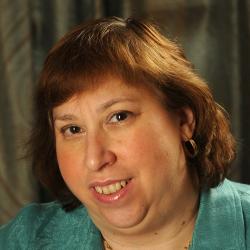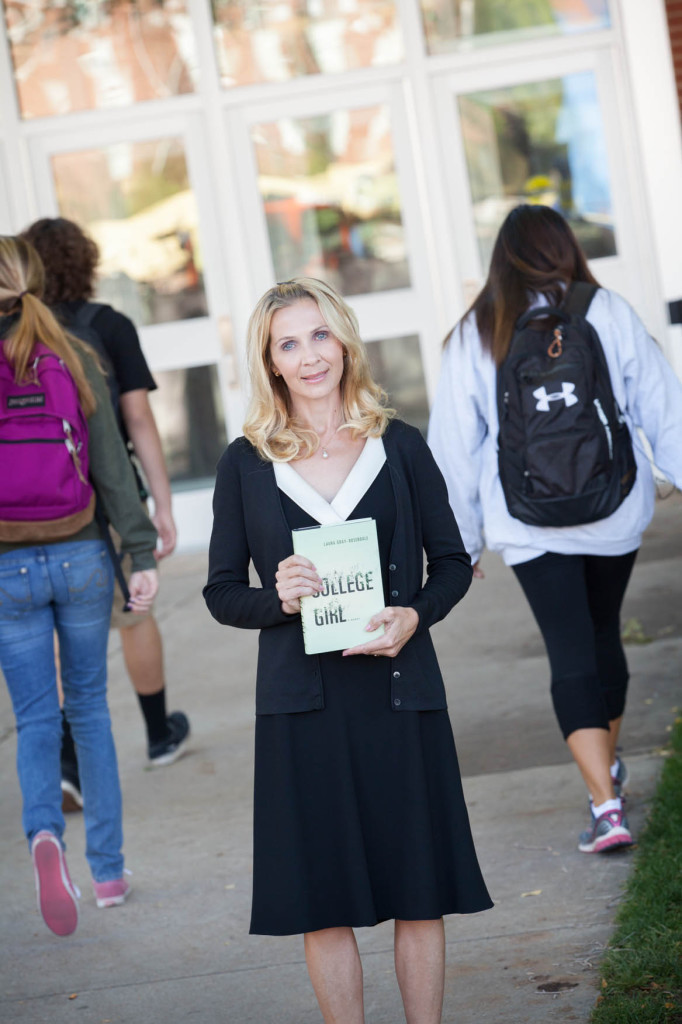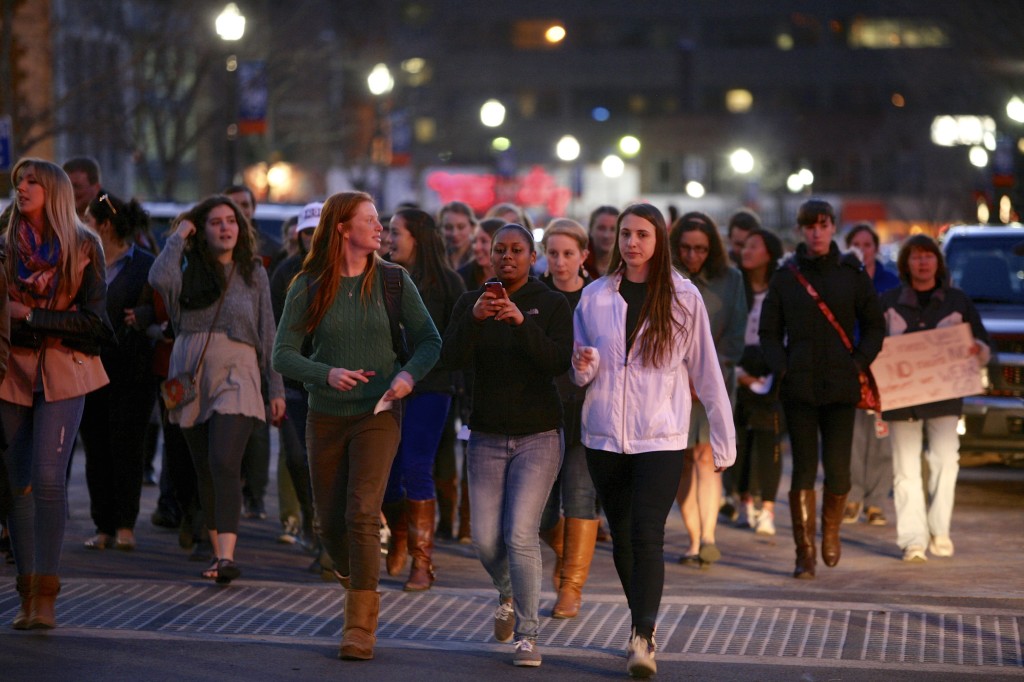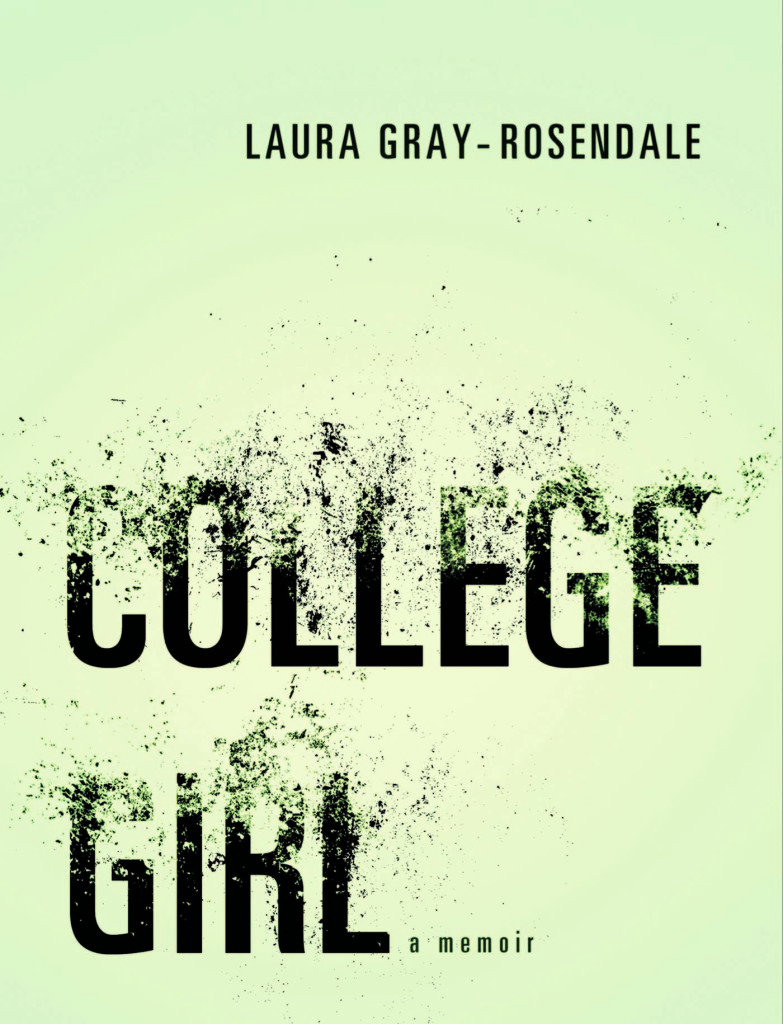 Those curt, clipped phrases offer just one account of what happened. Laura Gray-Rosendale spent nearly 25 years trying to square the news accounts with her own memories. The result is her riveting 2013 memoir, College Girl (State University of New York Press). The book raises nuanced questions about language, storytelling, memory and truth. She also draws attention to the troubling reality of sexual assault and rape of college students and the continuing need to improve colleges’ accountability in addressing the crimes.
The spare facts of the 1988 rape make the case worthy of a Law & Order: SVU episode. Police officers charged into the woman’s bedroom and found the accused rapist holding a screwdriver near a partially clothed woman on a bed. The man claimed to be the woman’s boyfriend, and then tried to escape.
The man’s father was Melvin E. Holm, a prominent local lawyer who had been accused in the previous weeks of offering cocaine in exchange for sex with a prostitute. He had also been charged with drunken driving on a number of occasions.
The grandfather of the accused, Melvin C. Holm, was the former CEO of Carrier Corp., which at the time was one of the county’s largest employers. He had served as chair of SU’s board of trustees from 1975 to 1981, and Carrier donated $2.75 million for naming rights to the university’s $27 million domed stadium, completed in 1980.
If this were a television drama, the wealth and prominence of Holm’s family would provide a dramatic twist and suggestions of special treatment. The details suggest a case that could easily be resolved. But Gray-Rosendale’s memoir describes a resolution that was both simpler and more complex.
Those curt, clipped phrases offer just one account of what happened. Laura Gray-Rosendale spent nearly 25 years trying to square the news accounts with her own memories. The result is her riveting 2013 memoir, College Girl (State University of New York Press). The book raises nuanced questions about language, storytelling, memory and truth. She also draws attention to the troubling reality of sexual assault and rape of college students and the continuing need to improve colleges’ accountability in addressing the crimes.
The spare facts of the 1988 rape make the case worthy of a Law & Order: SVU episode. Police officers charged into the woman’s bedroom and found the accused rapist holding a screwdriver near a partially clothed woman on a bed. The man claimed to be the woman’s boyfriend, and then tried to escape.
The man’s father was Melvin E. Holm, a prominent local lawyer who had been accused in the previous weeks of offering cocaine in exchange for sex with a prostitute. He had also been charged with drunken driving on a number of occasions.
The grandfather of the accused, Melvin C. Holm, was the former CEO of Carrier Corp., which at the time was one of the county’s largest employers. He had served as chair of SU’s board of trustees from 1975 to 1981, and Carrier donated $2.75 million for naming rights to the university’s $27 million domed stadium, completed in 1980.
If this were a television drama, the wealth and prominence of Holm’s family would provide a dramatic twist and suggestions of special treatment. The details suggest a case that could easily be resolved. But Gray-Rosendale’s memoir describes a resolution that was both simpler and more complex.
“A fistful of my hair jerks me back. There’s a slabby male figure leaning over me, pants bunched around his hips. I screech into the blackness, my fingers hunting for my glasses,” she writes. “A hand shuts off my scream…”The author writes dreamlike descriptions recounting her shock and confusion as events unravel: the close friend who faithfully accompanies her; her parents’ emotional distance as they deal with their divorce; the confusing legal system; a college culture oblivious to her pain.Gray-Rosendale survived another trauma that semester when a close friend and confidante who was studying abroad in London was killed Dec. 21, 1988, with 34 more SU students and 200 others when a terrorist bomb blew up Pan Am flight 103 over Lockerbie, Scotland. “I wasn’t able to grieve what happened to me until I grieved the loss of Miriam,” Gray-Rosendale said. “She was taken so violently and unexpectedly. I had so much trouble making sense of what happened to her and our classmates and what happened to me.” She credits Miriam (one of the few real names in the book) with inspiring her to finish her memoir. “She of all people would have wanted me to do it,” Gray-Rosendale said a month after the 25th anniversary of the Pan Am 103 bombing. “She was about speaking out, and I carry Miriam’s memory with me.” Despite immeasurable grief, shock and distraction, Gray-Rosendale graduated summa cum laude and Phi Beta Kappa in May 1990. (She later earned two master’s degrees and a doctorate at SU.) By the time Gray-Rosendale finished her senior year, Holm was in state prison, serving a sentence of four to 12 years. In August 1989, he accepted a plea bargain; he was convicted not of rape, but of first-degree burglary. It wasn’t until years later that Gray-Rosendale learned the legal details of the plea bargain that meant Holm never admitted that he raped her. While recovering from post-traumatic stress during graduate school, she began research to make sense of what happened. Over the course of nearly two dozen years, she turned to her journals; contacted her college roommates; collected medical and police reports; and met with a member of the Onondaga County District Attorney’s Office. She wrote several drafts of her story, which she called therapeutic, but not complete. “I had to be through with any self-pity that might muddy the experience, and I had to know enough to tell the story,” she said. “I could have rushed it. I wasn’t ready.” Her journal includes one especially troubling record: notes about a phone call on Thursday, Jan. 26, 1989, from an unidentified female SU dean.
“Did I know that (Holm’s) grandfather is the president of the city’s single-largest employer?” the dean asks, according to the journal. “Did I know his grandfather is on the university’s Board of Trustees? Did I know that this man is responsible for the largest sports complex on the university campus?”The woman describes Holm as “such a nice, polite, well-mannered boy… Honestly, it’s hard to believe he’d do something like this.” Gray-Rosendale was clear about the intent of the call: “I know they don’t really care how I am, that they’re after something, want to figure something out,” she wrote. “It could be whether I can be swayed not to testify against him if I learn who he is. It could be whether I’m going to make trouble for the university.” Twenty-five years later, Gray-Rosendale, a professor of English at Northern Arizona University, in Flagstaff, Ariz., downplays the suggestion that SU pressured her because of Holm’s family connections. “I don’t fault SU for responding in that way,” she said. “What I fault is the lack of protocols in place. I do not know who that person was to this day. I do think it is reasonable to say the system was not great. The system was broken.” In a prepared statement, SU said it could not confirm that the exchange had occurred. “This was 25 years ago and we don’t have any specific university records about this matter, so we are not able to verify what’s included in the memoir,” the statement says. “We can speak to our protocols today. We take any allegation of sexual violence seriously, and we have a series of policies and procedures in place to ensure that any allegation is promptly reported to and investigated by local law enforcement authorities.” Gray-Rosendale understands that response. She’s active with survivor groups and said she wrote her book, in part, to make it easier for others to tell their stories and find their way to recovery. She also advocates for strong college policies and laws that hold colleges responsible for making campuses safer. Gray-Rosendale did not contact SU when she was writing her memoir, nor did she name her rapist. “I saw it as my own story and not about the university,” she said. Randi Bregman, an executive of Vera House, a Syracuse agency that works to end sexual assault and domestic violence, had not heard Gray-Rosendale’s story, but she said Gray-Rosendale’s experience follows typical patterns. Bregman agrees that stronger laws and a better relationship between SU and law enforcement show major progress since 1988, but stressed sexual crimes still occur too often and too many victims do not find the support they need. It’s also not unusual for someone to try to dissuade a victim from pursuing charges against an attacker, Bregman said. “That’s a common experience,” she said. “It says to a victim, ‘We’re not really concerned about what happens to you.’ There’s so many places we still see the rush to protect the alleged perpetrator.” Bregman said the district attorney’s creation of the Special Victims Bureau in 1992 and the 1996 creation of Onondaga County’s Abused Persons Unit reflect important positive steps toward coordinating services to help victims. In 1990, the federal Clery Act (originally known as the Crime Awareness and Campus Security Act) was passed. It requires colleges and universities that participate in federal financial aid programs to keep and share information about crime on and near campus. The U.S. Department of Education monitors reporting, and colleges that do not comply face fines and risk federal financial aid programs. SU has also made changes. “All allegations of sexual assault or rape, even those that are reported as third party or anonymous, are reported to the campus law enforcement agency, the Syracuse University Department of Public Safety,” the university said in written responses to questions. Public Safety reports each case immediately to Syracuse police and the District Attorney’s office. Bregman noted that laws intended to help victims could also hinder them from reporting rape. “The offender’s name has to be reported, which often identifies the victim,” she said. “A victim may be exploring her options and not ready to report it.” According to the news accounts of Holm’s sentencing, his lawyer blamed alcohol for the crime. That is a misconception that continues today, Bregman said. “I don’t believe alcohol abuse causes an assault like this,” she said. “People like to see alcohol and drugs as an excuse.” Changes made since the late 1980s mean “there’s a clear understanding that a sex crime is a crime and there’s going to be an investigation,” said Rick Trunfio, first chief assistant district attorney. Trunfio was the first to lead the department’s Special Victims Bureau and met with Gray-Rosendale. Trunfio reviewed the case in response to questions about how the DA’s office would handle the case today. “This was ready to go to trial,” he said. “We didn’t just plead it out. At some point, there was a decision we’d be better off to plead this case.” In 1989, first-degree burglary carried the same penalty as a charge of first-degree rape. The sentencing guidelines allowed a maximum of 8 1/3 to 25 years in prison. Now, the minimum sentence for first-degree rape is five years. Even if Holm had been sentenced on the rape charge, he would not have been placed on a sex-offender registry, Trunfio pointed out. It wasn’t until 1994 that Megan’s Law was passed, requiring states to pass legislation forcing sex offenders to register with state sex offender registries. “The elements for rape require the victim to say, ‘he forcibly penetrated me,’” Trunfio said. “The facts that he’s found in an apartment with evidence of a break-in, he’s tied her up and has a weapon don’t mean we’d get a conviction.” Unlike in television crime dramas, “There’s no such thing as a slam dunk,” he said. What’s best for the victim is also part of the equation, he said, and sometimes the victim is not mentally strong enough to face the rapist in court. He rejects the suggestion the DA’s office was pressured by the Holm family’s wealth and prominence. “If people buy into that, it means they have no faith in the system,” he said. Trunfio was careful not to criticize colleagues who handled the case. (Bob Wildridge was district attorney at the time.) He said changes in sentencing guidelines and laws, such as requiring sex offender registries, would likely have led to a longer prison term for Holm. Holm was released from state prison in 1997, after serving eight years. “Do I think it was enough? No,” Trunfio said. “We would have insisted on a much lengthier sentence in a plea bargain.” It is unclear where Holm is living. A search of the state Department of Corrections public records indicates he has not been convicted of another crime in New York. His father, Melvin E. Holm, died in 2002 in a car crash in Florida. He was 60. His grandfather, Melvin C. Holm, died in 1991 at 74. Gray-Rosendale doesn’t focus on Holm. “When someone gets run over by a truck, you don’t focus on the make and model, you focus on the fact that you got run over,” she said. “What I meant to do was to convey my experience and not write an expose.” Her book is an attempt to address the science and experience of memory. “(Post-traumatic stress disorder) shapes the narratives that all survivors have around sexual violence,” she said. “All survivors have lapses in memory.” And while her research filled in gaps, her recollection remains intact. “The memories of that particular night are indelibly etched,” she said. “They haven’t changed in 25 years.” Her research solidified another truth: “Surviving sexual assault is not a private thing,” she said. “Often it’s a very public crime and affects a lot of people.” She chose the memoir form as a way to challenge the idea that there is only one story. “There are always multiple sets of perspectives on one act,” she said. “There’s this idea of truth in memoir about being as truthful as we can. The genre itself has relied on some fallacies that there can be just one story. That’s never the case.” For her, that meant stories of one roommate barricading herself in her own room during the attack; another who ran downstairs and called the police; and her parents and a brother dealing with family troubles. In her research, she heard details she didn’t know and learned of people’s recollections, sometimes conflicting. In the book, her parents seem especially inept. With time, Gray-Rosendale has overcome her disappointment at that. “At the time, I felt very alone,” she said. “Families are ill-equipped to handle this. There is not a roadmap. There is no one way. I do wish they could have been stronger and more involved at the time. I realized a long time ago this was not a possibility for them, and I forgave them for it.” Since the book’s publication, Gray-Rosendale has received many letters, phone calls and emails from survivors and families. Students at Northern Arizona University seek her advice. “There are many more avenues for survivors today,” she said. “There are ways to file a criminal suit, and universities are being held responsible far more than they were.” The newspaper accounts never mention the rape victim by name, a practice most media outlets still follow. The victim, The Post-Standard reported on Nov. 21, 1988, “was treated at Crouse Irving Memorial Hospital for scratches to the neck and leg and released.” The victim is not mentioned in subsequent stories about Holm’s indictment, plea and sentencing. Her memoir gave Gray-Rosendale a chance to tell her story. “Now I feel like I do own the narrative,” she said. “I’m in a different place about it. It is an experience that has shaped my life and always will.”
About the Author
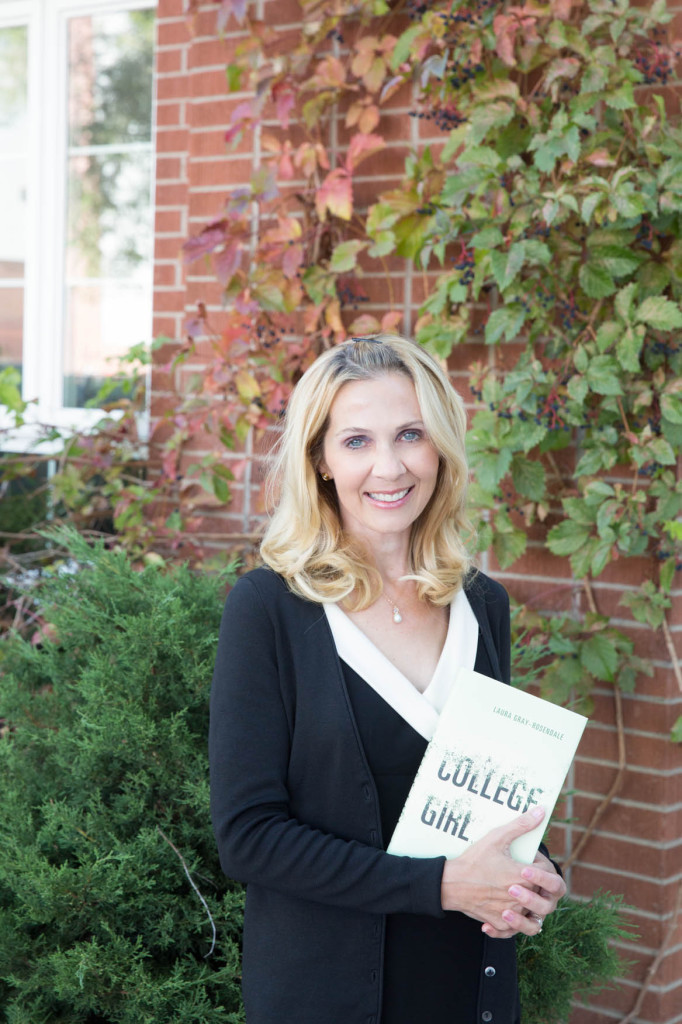 Laura Gray-Rosendale is an associate professor of English at Northern Arizona University, in Flagstaff, Ariz.
SU education: Bachelor of arts in English, 1990; master of arts in English, 1993; master of philosophy, 1996; doctorate in humanities, 1997.
Has written several books, including “Rethinking Basic Writing,” “Alternative Rhetorics,” “Fractured Feminisms,” “Radical Relevance,” and “Pop Perspectives.”
“College Girl” was published in 2013 by State University of New York Press.
Gray-Rosendale addressed concerns about legislation to hold colleges accountable for sex crimes in “Making Campuses Safer From Rape,” published in the Chronicle of Higher Education, August 26, 2013, http://bit.ly/1m8tgP0.
On Nov. 20, 1989, exactly one year after Michael E. Holm raped Laura Gray in a university-area apartment, a New York Times article chronicled a disturbing series of rapes at Syracuse University.
Laura Gray-Rosendale is an associate professor of English at Northern Arizona University, in Flagstaff, Ariz.
SU education: Bachelor of arts in English, 1990; master of arts in English, 1993; master of philosophy, 1996; doctorate in humanities, 1997.
Has written several books, including “Rethinking Basic Writing,” “Alternative Rhetorics,” “Fractured Feminisms,” “Radical Relevance,” and “Pop Perspectives.”
“College Girl” was published in 2013 by State University of New York Press.
Gray-Rosendale addressed concerns about legislation to hold colleges accountable for sex crimes in “Making Campuses Safer From Rape,” published in the Chronicle of Higher Education, August 26, 2013, http://bit.ly/1m8tgP0.
On Nov. 20, 1989, exactly one year after Michael E. Holm raped Laura Gray in a university-area apartment, a New York Times article chronicled a disturbing series of rapes at Syracuse University.
One woman was raped in the bushes near the chancellor’s residence at 300 Comstock Ave. Six rapes were reported in two months; two rapes had been reported in the previous two years combined. An SU official told the Times that SU did not have a larger problem with rape than other campuses, but said, “Rape victims, who often are reluctant to report attacks to the authorities for fear of not being believed, now come forward.” At the time, SU was planning to open a center that would assist rape victims and educate students about sexual violence. The campus also pledged to develop an official policy that included disciplinary measures and encouraged students to report assault to police and SU officials. Both the advocacy center and SU’s policy came too late to help Gray. The 1999 New York Times bestselling memoir Lucky tells the story of another Syracuse University student’s experience with rape. Alice Sebold was raped by a stranger in Thornden Park in May 1981. The book’s title comes from a remark from the police. After she reported the crime, police noted that she should consider herself “lucky” since a young woman had once been murdered near where she was raped. Sebold is a 1984 SU graduate. She studied with some of SU’s greatest writing teachers, including Tess Gallagher, Raymond Carver, Tobias Wolff and Hayden Carruth. She is also the author of the 2004 novel Lovely Bones. Paramount produced a movie based on the book in 2010. In a New York Times essay a decade before her memoir was published, Sebold wrote about her rape. “The wall of silence and assumptions that surround the crime are one of the most painful results of rape,” she wrote. “It is a sad fact that despite increased attention to the issue, opinion is still shaped by a dark collection of stereotypes.”
White House Commitment
 Barack Obama created the White House Task Force to Protect Students from Sexual Assault during an event Jan. 22 for the Council on Women and Girls. Here are excerpts from his remarks:
“It is estimated that one in five women on college campuses has been sexually assaulted during their time there… Three years ago, we sent every school district, college and university that receives federal funding new instructions clarifying their legal obligations to prevent and respond to sexual assault. And we have seen progress, including an inspiring wave of student-led activism, and a growing number of students who found the courage to come forward and report attacks.
“…Today I will sign a presidential memorandum creating the White House Task Force to Protect Students from Sexual Assault. And we’re going to work with colleges and universities and educational institutions of all kinds across America to help them come up with better ways to prevent and respond to sexual assault on their campuses…”
“Some of you have worked on these issues for years. You know how long it took for our country to get to where we are now. And it didn’t just take new laws. It took a fundamental change in our culture — a shift in our attitudes about how we think about sexual violence, and how much we value the lives and dignity of our wives and sisters and daughters and sons. … But now it’s up to each of us — every single one of us — to keep up that momentum.”
Barack Obama created the White House Task Force to Protect Students from Sexual Assault during an event Jan. 22 for the Council on Women and Girls. Here are excerpts from his remarks:
“It is estimated that one in five women on college campuses has been sexually assaulted during their time there… Three years ago, we sent every school district, college and university that receives federal funding new instructions clarifying their legal obligations to prevent and respond to sexual assault. And we have seen progress, including an inspiring wave of student-led activism, and a growing number of students who found the courage to come forward and report attacks.
“…Today I will sign a presidential memorandum creating the White House Task Force to Protect Students from Sexual Assault. And we’re going to work with colleges and universities and educational institutions of all kinds across America to help them come up with better ways to prevent and respond to sexual assault on their campuses…”
“Some of you have worked on these issues for years. You know how long it took for our country to get to where we are now. And it didn’t just take new laws. It took a fundamental change in our culture — a shift in our attitudes about how we think about sexual violence, and how much we value the lives and dignity of our wives and sisters and daughters and sons. … But now it’s up to each of us — every single one of us — to keep up that momentum.”



